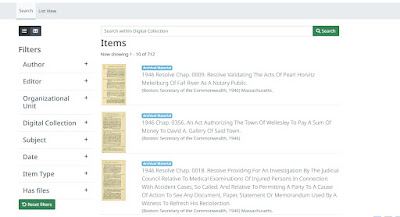This post is jointly written by our two Special Collections interns, who have been working their way through unprocessed collections, arranging and describing them so that they'll be accessible to researchers. While working with the recently donated State House Press Association Records, they stumbled upon an interesting character!
 |
| Charlsie and Erin surrounded by records |
Eggs, freemasons, and corporate greed: three pieces of Grover C. Hoyt’s fall from grace. A member of the State House Press Association in the 1920s, Grover C. Hoyt grew up in Biddeford, Maine and moved to Boston as a young man where he started work as a freelance news reporter and founded the Legislative Reporting Service (from the
Portland Press Herald, 1960). He was also heavily involved in the freemason community, serving as the Massachusetts State President of the National League of Masonic Clubs.

Hoyt fell into hot water for a variety of rule violations, which resulted in a 1929 hearing before the Executive Committee of the Massachusetts State House Press Association. The first of Hoyt’s offenses was selling eggs out of the Press Association office. Hoyt claimed that it should be of no concern to the Association or Legislature as the eggs were from his farm in Maine and were sold as a convenience for his friends and some members of the custodial staff. However, in a letter read during the hearing, Wendell D. Howie testified that “...in Hoyt’s absence the other persons in the room have frequently been asked to act as egg salesmen.” This does not align well with Hoyt’s argument as it is one thing to casually sell eggs to friends, and another for him to ask his peers to sell eggs on his behalf. He argued that there is nothing in the Association’s constitution that explicitly forbade his actions, but if the Association asked, he would cease sales without complaint.
Furthermore, a Mr. Doherty claimed he saw Hoyt using letterhead for an external fraternal organization that bore the State Seal, which was not only improper but implied that the organization had an office within the building. Hoyt countered that no such letterhead existed, but the letterhead for the Canopy Club, an organization comprised of employees of the state, used an image of the State House’s golden dome which may have elicited confusion.
However, Hoyt later admitted that he did use State House letterhead to conduct correspondence as Massachusetts State President of the National League of Masonic Clubs. He also admitted to receiving mail from the organization at the State House. Conducting such correspondence within the State House was not only against the rules of the Press Association, but it could also indicate to others that the Freemasons had an office in the building.
At one point, Hoyt claimed that letterhead was stolen from his desk, and a letter criticizing a member of the House was forged and sent on his behalf despite no such letter being mentioned in proceedings. He believed that it was a part of a larger scheme to get him kicked out of the Press Association and that the former President, Wendell D. Howie, was appointed to that position specifically to ruin his career.
Finally, the Executive Committee accused Hoyt of obtaining information about the actions of the legislature before it was a matter of the public record and selling it to corporations through his Legislative Reporting Service. Corporations could subscribe to this service and Hoyt would send them copies of recently enacted or amended bills. Hoyt claimed that he only sent bills after they were officially enacted, thus making them public record. However, there was sufficient reasoning to believe that he was obtaining said information through questionable means prior to its announcement to both the public and other reporters.
Even if Hoyt was telling the truth, there was still concern surrounding him conducting his work in the press office as it wasn’t considered newspaper work. The Press Association constitution specifies that members of the Association are not to engage in any work outside of their reportorial responsibilities while in the office. Hoyt protested this accusation claiming that the rules specify “reportorial work” and do not name newspapers as the only outlet for such work. Howie also reported that at times, Hoyt would use nearly all of the desks in the room to keep up with the work required for his service and he would do a poor job of cleaning up after himself.
Hoyt also served as the Secretary of the Board of Appeal under the Motor Vehicle Liability Act and admitted he was conducting work for that position in the press office and recognized that it was against the rules. Hoyt’s defense was simply that he had no other place to do it. He claims that the Board of Appeal was promised quarters in the State House but have yet to receive them despite repeated requests.
Using the press office to sell eggs, conducting unrelated work, and selling information to corporations was a clear violation of Section 4, Article IV of the constitution of the Press Association, which prohibits reporters from using the rooms for unauthorized purposes. As a result, the Executive Committee voted to dismiss Hoyt from the Press Association.
All of this to say, working in the Special Collections Department, you never know what kind of hidden gems you’re going to stumble upon. Sometimes it’s a rare book, or an unexplainable receipt for 25 ocarinas, and other times it’s a scandal involving selling eggs in the State House.
All of this information and more can be found in the State House Press Association Records now open for research in the Special Collections department. Contact
special.collections@mass.gov to schedule an appointment!
Erin Wood and Charlsie Wemple
Special Collections Interns











































